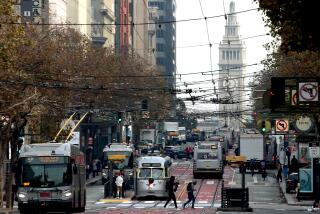How Steve Jobs’ Macintosh failed and still changed computing
This morning much of the tech world is celebrating the 30th anniversary of the original Macintosh computer.
It was Jan. 24, 1984, when a young Steve Jobs -- sporting a goofy bow tie -- stepped onto a stage in Cupertino, Calif., and unveiled the Macintosh. However deeply cynical we have grown about product launches, there is no doubt about how genuine the enthusiasm was in the auditorium that day.
PHOTOS: Top 10 tech fails of 2013
Just watch the above video to the end and see the audience go completely bonkers. As a bonus, you get to see Jobs showing early signs of his stagecraft.
The event stands as one of Silicon Valley’s most mythic -- a single moment that everyone can point to and say, “That was when everything changed.”
And that’s sort of true. But the reality, as always, is more complex.
In his recent biography of Steve Jobs, author Walter Isaacson managed to push past much of the mythology around the creation and launch of the Mac.
As Isaacson recounts it, the creation of the Macintosh was a messy one because Jobs essentially pitted his team against another Apple team building a different personal computer called the Lisa. The Lisa was released a full year before the Macintosh.
Jobs was deeply resentful that he had been kicked off the team building the Lisa. He was determined that the Macintosh would be better and cheaper.
But before its launch, Jobs lost a fight with his handpicked CEO, John Sculley, over marketing costs. Sculley insisted that the Macintosh be priced $500 more than Jobs wanted, at $2,495, to include the cost of advertising and publicity.
Almost 25 years later, Jobs still blamed the price for the device’s problems, telling Isaacson: “It’s the main reason the Macintosh sales slowed and Microsoft got to dominate the market.”
But the Macintosh had many other problems.
“The problem was a fundamental one: It was a dazzling but woefully slow and underpowered computer, and no amount of hoopla could mask that,” Isaacson wrote.
The Macintosh shipped with only 128K of memory, compared with the 1,000K RAM in the Lisa. It also lacked an internal hard drive, at Jobs’ insistence. And the Macintosh didn’t have a fan (Jobs believed that it “distracted from the calm of the computer,” Isaacson wrote.)
“This caused many component failures and earned the Macintosh the nickname ‘the beige toaster,’ which did not enhance its popularity,” Isaacson wrote.
Apple sold 70,000 Macintosh computers by April. But by the end of the year, it was selling only 10,000 a month. By January 1985, with the company discontinuing the Lisa, Apple was plunged into a crisis.
The result over the next several months was a showdown of sorts between Sculley and Jobs that the latter eventually lost, leading to his departure from Apple that summer.
Less than 18 months after the launch of the Macintosh brought Jobs international acclaim, he was out of the company he founded.
So how did Apple and the Mac manage to survive?
In 1986, Apple came out with the Macintosh Plus, which had 1 megabyte of memory. That machine was powerful enough to run new desktop publishing software that made it a hit with creative types.
Over time, of course, it turned out that Apple and Jobs were right about many of the feature of the original Macintosh. Jobs believed in designing the Macintosh that it was important for hardware and software to be tightly integrated, a philosophy Apple continues to embrace to this day.
And of course the graphical user interface and the mouse have become standards of personal computing.
As a result, the original Macintosh has had a legacy that stretches far beyond its own success as a product.
ALSO:
Apple to roll out larger-screen iPhones, scrap 5c, report says
iPhone 5s users gobble up more data than others, report says
Carl Icahn buys $500 million more of Apple shares, issues letter







